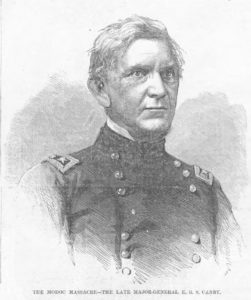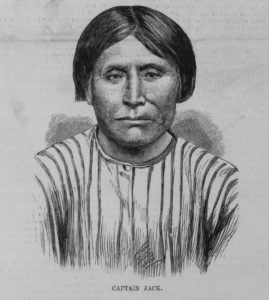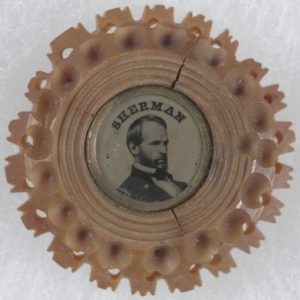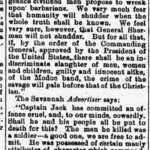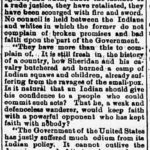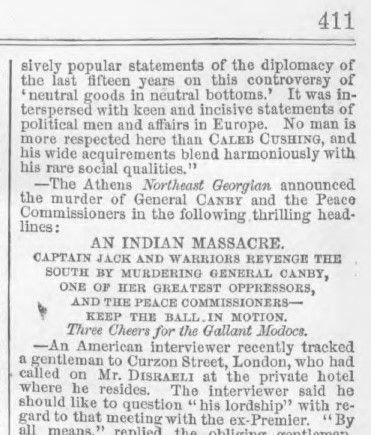From the April 26, 1873 issue of Harper’s Weekly:
The treacherous murder of General CANBY and the Rev. Dr. THOMAS by the Modoc Indians during a conference to which the general and the Peace Commissioners had been invited by “Captain JACK” is one of the most tragical events in the history of Indian wars. Captain JACK, secure in the natural fastness of the lava beds, had persistently rejected all peaceful overtures, and the Commissioners had come to the conclusion that the negotiations were a failure. On the 10th of April several Indians strolled into General CANBY’s camp, and were generously treated, receiving presents of clothing and provisions, When they left the Commissioners sent a message to Captain JACK, asking for a talk the next morning at a point about half a mile outside the picket line.
The next morning an Indian named “BOSTON CHARLEY” came into the camp, and told the Commission that Captain JACK and five other Indians would meet the Commission outside the lines. BOSTON CHARLEY and BOGUS CHARLEY, who had been in the camp all night, then mounted a horse and started for the lava bed. About an hour after their departure General CANBY, Mr. DYER, Dr. THOMAS, and Mr. A.B. MEACHAM, with FRANK RIDDLE and his squaw for interpreters, started for the place appointed. The party arrived at the appointed place, and were closely watched by the signal officer, Lieutenant ADAMS, from the signal-station on a hill overlooking the camp. About half an hour after the party had arrived a cry from the signal-station was heard, saying that the Indians had attacked the Peace Commission, and that another band of Indians had attacked Colonel MASON’s camp, on the east side of Tule Lake.
The troops immediately hastened to the scene of the conference, under command of Colonel GREEN. On the way Mr. DYER was met, who thought he was the only member of the party who had escaped; but soon afterward the interpreter RIDDLE and his squaw reached the lines. He gives the following account of the massacre:
Mr. MEACHAM made a short speech to the Indians, followed by General CANBY, and then Dr. THOMAS. Then Captain JACK made a speech, asking for Hot Creek and Cottonwood, the places now occupied by FAIRCHILD and DORRIS, for a reservation. Mr. MEACHAM told JACK that it was not possible to give him what he asked. SCHONCHIN told Mr. MEACHAM to say no more; that he (MEACHAM) had said enough upon that subject; and while SCHONCHIN was speaking Captain JACK got up and walked behind the others, turned back, and exclaimed, “All ready.” He then drew his pistol and snapped a cap at General CANBY. He cocked his pistol again and fired. General CANBY fell dead, shot under the eye. SCHONCHIN then shot Mr. MEACHAM in the shoulder and head, but though severely wounded he was at last accounts still alive. Boston CHARLEY and another Indian shot and killed Dr. THOMAS. HOOKER JIM chased Mr. DYER for some distance, but DYER turned upon him with pistol in hand, and JIM ran.
The bodies of General CANBY and Dr. THOMAS were found nearly stripped of clothing. Pausing only an instant to cast a glance at the inanimate form of their beloved commander, the troops dashed on, and the two leading batteries were within a mile of the stronghold of the murderers when the bugle sounded a “halt.” Lieutenant EGAN and Major WRIGHT’s companies of Twelfth infantry were behind the artillery, and then came up the cavalry. General GILLEM and Colonel GREEN and staff were up with the men, but as soon as they found that the Indians had all got back to their stronghold the troops were ordered to fall back, and active operations were for the time deferred. It was supposed when the courier left the camp that an attack would be made on the Indians in the lava beds within twenty-four hours.
The attack on Colonel MASON’s camp, which fortunately failed of success, occurring at the same time of the massacre, shows the treachery of Captain Jack to have been deliberately planned. His object was doubtless to capture or kill the commanding officers of both posts as well as the Peace Commissioners.
On receiving intelligence of this terrible massacre, General SHERMAN at once gave orders by telegraph to General SCHOFIELD, commanding the Division of the Pacific, to advance all available troops against the Modoc Indians, administer the severest punishment, and take no prisoners. General SHERMAN has also issued the following order, announcing the death of General CANBY:
“HEAD-QUARTERS of the Army,
WASHINGTON, April 14,1873.
“GENERAL ORDER No. 3.-It again becomes the sad duty of the general to announce to the army the death of one of our most illustrious and most honored comrades. Brigadier-General Edward R. S. CANBY, commanding the Department of the Columbia, was on Friday last, April 11, shot dead by the chief, Jack, while he was endeavoring to mediate for the removal of the Modocs from their present rocky fastness on the northern border of California to a reservation where the tribe could be maintained and protected by the civil agents of the government.
“That such a life should have been sacrificed in such a cause will ever be a source of regret to his relations and friends. Yet the general trusts that all good soldiers will be consoled in knowing that CANBY lost his life on duty, and in the execution of his office; for he had been especially chosen and appointed for this delicate and dangerous trust by reason of his well-known patience.and forbearance, his entire self-abnegation and fidelity to the expressed wishes of his government, and his large experience in dealing with the savage Indians of America. He had already completed the necessary military preparations to enforce obedience to the conclusions of the Peace Commissioners, after which he seems to have accompanied them to a last conference with the savage chiefs, in supposed friendly council, and there met his death by treachery outside of his military lines, but within view of the signal-station. At the same time one of the Peace Commissioners, was killed outright and another mortally wound and a third escaped unhurt. Thus perished one of the kindest and best gentlemen of this or any other country, whose social equaled his military virtues. To even sketch his army history would pass the limits of a general order,and I must here suffice to state that General CANBY began his military career as a cadet at West Point in the summer of 1835, graduating in 1839, since which time he has continually served, thirty-eight years, passing through all the grades to major general of volunteers and brigadier-general of the regular army. He served his early life with marked distinction in the Florida and Mexican wars, and the outbreak of the civil war found him on duty in New Mexico, where, after the defection of his seniors, he remained in command,and defended the country successfully against a formidable inroad from the direction of Texas; afterward, transferred to the East to a more active and important sphere, he exercised various high commands, and at the close of the civil war was in chief command of the Military Division of the West Mississippi, in which he had received a painful wound, but had the honor to capture Mobile, and compel the surrender of the rebel forces of the Southwest.
“Since the close of the war he has repeatedly been chosen for special command, by reason of his superior knowledge of law and civil government, his known fidelity to the wishes of the Executive, and his chivalrous devotion to his profession, in all of which his success was perfect. When fatigued by a long and laborious career in 1869, he voluntarily consented to take command of the Department of the Columbia, where he expected to enjoy the repose he so much coveted. This Modoc difficulty arising last winter, and it being extremely desirous to end it by peaceful means, it seemed almost providential that it should have occurred within the sphere of General CANBY’s command. He responded to the call of his government with alacrity, and has labored with a patience that deserved better success: but alas! the end is different from that which he and his best friends had hoped for, and he now lies a corpse in the wild mountains of California, while the lightning flashes his requiem to the furthermost corners of the civilized world. Though dead, the record of his fame is resplendent with noble deeds well done, and no name on our army register stands fairer or higher for the personal qualities that command the universal respect, honor, affection, and love of his countrymen. General CANBY leaves to his country a heart-broken widow, but no children. Every honor consistent with law and usage shall be paid to his remains, full notice of which will be given as soon as his family can be consulted and arrangements concluded. By order of General SHERMAN.
“W.D.WHIPPLE Adjutant-General.”
General CANBY was placed in control of all negotiations with the Indians on the special request of the Secretary of the Interior. The members of the Commission were directed to report to him, and to send no dispatches or recommendations without first submitting them to him. He was also invested with authority by the Secretary of the Interior, through the General of the Army, to change the Commissioners in his discretion. He acted on this so far as to add one member to the Commission. General CANBY at once assumed control, and since the 10th of March the War Department and the military have had charge of the negotiations. The general sympathized entirely with the previous attempts to bring the Modocs under peaceable subjection by fair and honorable treatment, and it was in the effort to carry out this humane policy that he met his death. General CANBY was a Kentuckian by birth. He had nearly reached the age of fifty-four, had passed through two great wars with honor and distinction, to fall at last by the treacherous hand of a besotted Indian.
General Canby was born in Kentucky and graduated from West Point in 1839. He served in the United States Army throughout his career. After the war he commanded several military districts in the reconstructing South. In its April 16, 1873 issue The Daily Phoenix from Columbia, South Carolina quoted a couple other southern newspapers that didn’t have too much personal sorrow at General Canby’s death, considering his actions when in “dominion” over the southern states:
___________________________________________
In its May 17, 1873 issue, Harper’s Weekly reproduced a headline from a newspaper in Athens, Georgia:
You can read more about Captain Jack at Legends of America.

